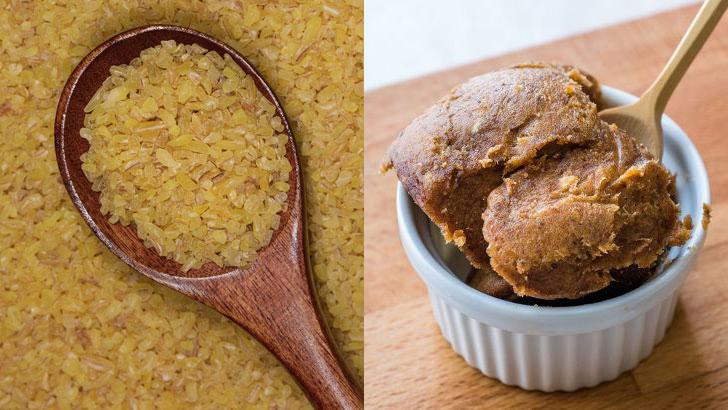Bulgur vs Miso: How Are They Different?

Although bulgur and miso belong to different food groups, while bulgur belong is a grain, and miso belong to legumes food group, and it’s not that common to compare foods from different groups, people are often interested in these comparisons as well.
That’s why we decided to create an in-depth article that compares bulgur and miso, their nutritional values, similarities, differences, macronutrients, and micronutrients – vitamins and minerals.
Generally speaking, foods from grains and legume food groups are both high in carbs and protein and valuable addition to a plant-based diet.
Now, let’s see how bulgur and miso compare specifically.
Bulgur
Bulgur (Triticum aestivum) is a type of whole wheat that is made by steaming, drying, and then coarsely grinding wheat berries.
It is a good source of carbohydrates, dietary fibers, and small amounts of vitamins and minerals like iron, zinc, and B-vitamins. It is also rich in antioxidants and protein, making it a valuable food for vegetarians and vegans.
Bulgur is a staple ingredient in Middle Eastern and Mediterranean cuisines, often used in dishes such as tabbouleh and kibbeh. It can also be used in soups, stews, and as a stuffing. It is also gluten-free and easy to digest, making it a great option for people with gluten sensitivities or celiac disease.
Bulgur is considered a functional food, as it has been shown to positively impact health when consumed regularly as part of a balanced diet. It is also a sustainable crop, as it can be grown in poor soil conditions and is resistant to pests and diseases.
Bulgur is an excellent source of Vitamin B3 (Niacin).
It also contains a good amount of Vitamin B1 (Thiamine), Vitamin B5 (Pantothenic acid), and Vitamin B6 (Pyroxidine) and some Vitamin B2 (Riboflavin), and Vitamin B9 (Folate).
Miso
Miso (fermented soybean paste) is a traditional Japanese condiment made by fermenting soybeans with salt and a type of fungus called koji.
It is a thick, paste-like substance that adds flavor to various dishes, such as soups, sauces, and marinades.
Miso is an important part of Japanese cuisine and has been used for centuries to preserve and enhance food flavor.
One of the main health benefits of miso is its high protein content. Miso is made from soybeans, a good source of plant-based protein, making it a popular choice for vegetarians and vegans.
Miso also contains many nutrients, including vitamins, minerals, and amino acids. The fermentation process used to make miso also helps to increase the bioavailability of these nutrients, making them easier for the body to absorb.
In terms of health benefits, miso has been shown to have many positive effects on the body.
It is a good source of probiotics, which are beneficial bacteria that help balance the gut microbiome.
Miso may also help to reduce the risk of certain health conditions, such as high blood pressure and high cholesterol, due to its high content of antioxidants and other beneficial compounds.
Miso is not an excellent source of any particular vitamin.
However, it also contains a good amount of Vitamin B2 (Riboflavin), Vitamin B6 (Pyroxidine), and Vitamin K and some Vitamin B1 (Thiamine), Vitamin B3 (Niacin), Vitamin B5 (Pantothenic acid), and Vitamin B9 (Folate).
Bulgur vs Miso Nutrition
Now that we’ve described the origin, taste, and usage of these foods, we can move to the most interesting part – comparing bulgur vs miso.
This comparison will start by comparing the caloric value of bulgur and miso and their macronutrients and then go more in-depth by analyzing their vitamin and mineral content.
| Bulgur | Miso | |
|---|---|---|
| Energy | 342 kcal | 198 kcal |
| Carbs | 75.9 g | 25.4 g |
| Sugar | 0.41 g | 6.2 g |
| Fiber | 12.5 g | 5.4 g |
| Protein | 12.3 g | 12.8 g |
| Fat | 1.33 g | 6.01 g |
| Saturated Fat | 0.232 g | 1.02 g |
Bulgur vs Miso Calories
Most calories in raw grains and legumes come from carbs. Peanuts are an exception here, but they are often considered a nut instead of a legume because of their nutritional profile.
Comparing miso vs bulgur for weight loss, miso is slightly lower in calories, with 198 calories per 100 grams, compared to 342 calories per 100 grams of bulgur.
However, both bulgur and miso can and should be a part of a healthy diet, and neither one shouldn’t be avoided if you’re looking to lose weight.
Bulgur vs Miso Protein
Legumes and most legume products, including bulgur and miso, are important sources of plant-based protein.
Miso offers around 4% more protein than bulgur.
Miso has 12.8 grams of protein per 100 grams, while bulgur has 12.3 grams of protein per 100 grams.
Bulgur vs Miso Carbs
Counting carbs can be important for some people for different reasons, including blood sugar control, weight management, or athletic performance.
It’s also important for people on a keto diet, so let’s compare the carbs content in bulgur and miso.
The total amount of carbohydrates is around 67% higher in bulgur than in miso. It have 75.9 grams per 100 grams, compared to 25.4 grams in miso.
There’s less sugar in bulgur than in miso, 94% precisely.
One handful of bulgur (28 grams) contains 0.1 grams of sugar, while the same amount of miso contains 1.7 grams.
Lastly, let’s take a look at the dietary fiber in bulgur and miso.
Dietary fiber keeps the digestive system healthy and helps with weight management by promoting a sense of fullness.
With 3.5 grams of fiber per portion, bulgur is a better source of fiber than miso which bulgur offers 1.5 grams per portion.
Bulgur vs Miso Fats
Like most other grains and legumes, with the exception of lupins and peanuts, bulgur and miso are low in fat.
Fats in bulgur and miso are mostly healthy unsaturated fats. They are naturally cholesterol-free and trans-fat-free.
Total fat in bulgur and miso:
- Bulgur: 1.3 grams per 100 grams
- Miso: 6 per 100 grams
Speaking of saturated fats, bulgur is 80% lower in saturated fats.
Bulgur and miso contain 0.2 grams and 1 grams of saturated fat per 100 grams, respectively.
Bulgur vs Miso Vitamins Content
This section will discuss the vitamin content of bulgur and miso.
Vitamins are micronutrients, meaning we need only a small amount. However, they are very important for many processes in our bodies.
Bulgur has a higher amount of vitamin A, vitamin B2 (Riboflavin), vitamin B12 (Cobalamin), and vitamin K.
However, miso has a higher amount of vitamin B1 (Thiamine), vitamin B3 (Niacin), vitamin B5 (Pantothenic acid), vitamin B6 (Pyroxidine), vitamin B9 (Folate), and vitamin E.
Bulgur and miso contain the same amount of vitamin C, and vitamin D.
The following table shows the exact amount of vitamins bulgur and miso contain side by side, so you can easily compare them.
| Bulgur | Miso | |
|---|---|---|
| Vitamin A | 9 IU | 87 IU |
| Vitamin C | 0 | 0 |
| Vitamin D | 0 | 0 |
| Vitamin B1 (Thiamine) | 0.232 mg | 0.098 mg |
| Vitamin B2 (Riboflavin) | 0.115 mg | 0.233 mg |
| Vitamin B3 (Niacin) | 5.11 mg | 0.906 mg |
| Vitamin B5 (Pantothenic acid) | 1.04 mg | 0.337 mg |
| Vitamin B6 (Pyroxidine) | 0.342 mg | 0.199 mg |
| Vitamin B9 (Folate) | 27 µg | 19 µg |
| Vitamin B12 (Cobalamin) | 0 | 0.08 µg |
| Vitamin E | 0.06 mg | 0.01 mg |
| Vitamin K | 1.9 µg | 29.3 µg |
Bulgur vs Miso Minerals Content
Minerals are important for our body to function properly. We need only a small amount of minerals, so they are called micronutrients.
Some minerals, like iron, calcium, zinc or, iodine, are relatively hard to get on a plant-based diet, so it’s important to choose your foods thoughtfully. This part of the bulgur and miso comparison focuses on their mineral content.
Bulgur is a better source of calcium, copper, iron, selenium, sodium, and zinc than miso.
On the other hand, miso is a higher amount of magnesium, manganese, phosphorus, and potassium.
Bulgur and miso contain the same amount of fluoride.
Check out the table below to learn how bulgur and miso compare when it comes to mineral content.
| Bulgur | Miso | |
|---|---|---|
| Calcium | 35 mg | 57 mg |
| Copper | 0.335 mg | 0.42 mg |
| Fluoride | 0 | 0 |
| Iron | 2.46 mg | 2.49 mg |
| Magnesium | 164 mg | 48 mg |
| Manganese | 3.05 mg | 0.859 mg |
| Phosphorus | 300 mg | 159 mg |
| Potassium | 410 mg | 210 mg |
| Selenium | 2.3 µg | 7 µg |
| Sodium | 17 mg | 3730 mg |
| Zinc | 1.93 mg | 2.56 mg |
The Final Word
Bulgur and miso are highly nutritious and a great addition to a plant-based diet.
Both bulgur and miso are high in specific vitamins and minerals, and including them in your diet will give you the most benefits they offer.
Antioxidants found in grains and legumes can help to protect cells from damage and may reduce the risk of certain diseases and the effects of aging.
Additionally, the fiber and other nutrients in these foods can support the health of the digestive system and may even help to prevent certain digestive cancers.
Legumes and grains are a versatile food that can be incorporated into any meal of the day, including breakfast, lunch, or dinner. They can be served hot or cold, making them a convenient and tasty addition to a variety of dishes.
Holy Peas has strict sourcing guidelines and draws only from high-quality sources, including peer-reviewed studies, academic research institutions, and medical journals, associations and government institutions. Read more about our process.
- Bulgur Nutrients, U.S. Department of Agriculture, Agricultural Research Service https://fdc.nal.usda.gov/fdc-app.html#/food-details/167746/nutrients
-
Miso Nutrients, U.S. Department of Agriculture, Agricultural Research Service https://fdc.nal.usda.gov/fdc-app.html#/food-details/167746/nutrients
-
Listing of vitamins, Harvard Health Publishing, Harvard Medical School https://www.health.harvard.edu/staying-healthy/listing_of_vitamins/
-
Appendix 7. Nutritional goals for age-sex groups based on dietary reference intakes and Dietary Guidelines recommendations. (n.d.).
https://health.gov/dietaryguidelines/2015/guidelines/appendix-7/
-
International tables of glycemic index and glycemic load values 2021: a systematic review
https://academic.oup.com/ajcn/article/114/5/1625/6320814?login=false
-
Health Claim Notification for Saturated Fat, Cholesterol, and Trans Fat, and Reduced Risk of Heart Disease
https://www.fda.gov/food/food-labeling-nutrition/health-claim-notification-saturated-fat-cholesterol-and-trans-fat-and-reduced-risk-heart-disease
-
Nutrient Recommendations: Dietary Reference Intakes (DRI), Food and Nutrition Board of the National Academies of Sciences Engineering, and Medicine
https://ods.od.nih.gov/HealthInformation/nutrientrecommendations.aspx
-
Protein And Amino Acid Requirements In Human Nutrition, WHO
https://apps.who.int/iris/bitstream/handle/10665/43411/WHO_TRS_935_eng.pdf
-
Nutrition Facts Labeling RDIs Nutrients, U.S. Food and Drug Administration
https://www.fda.gov/media/99069/download
-
Nutrition Facts Labeling DRVs Food Components, U.S. Food and Drug Administration
https://www.fda.gov/media/99059/download
- It's written and or reviewed by an expert.
- We cite relevant studies and trusted sources.
- It's regularly updated.
Read more about our process and team.






